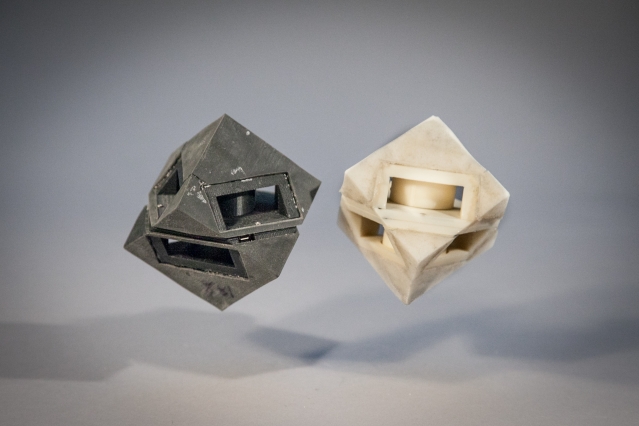At MTI, we have developed 3D-printing of robot cases with depreciation.

Most of the models of modern robots are complex systems with a large number of components and electronic components. Disabling such a robot is quite simple. Enough bounce or fall from a relatively small height. In order to protect their devices from damage due to mechanical stress, many manufacturers use body reservation or its depreciation.
At the Massachusetts Institute of Technology , a new method of protection was proposed - not armor, but a “skin” printed on a 3D printer, which absorbs the vast majority of shocks. This is not a panacea, but this “skin” protects the vulnerable electronic inside of a robot much better than traditional materials.
The depreciation cover printed on a 3D printer can be used not only to protect robots, but also to use it in the manufacture of drones, smartphones, helmets and even shoes.
')
The technique developed by the Americans, called "programmable viscoelastic material" (programmable viscoelastic materia, PVM). The development allows you to set the protective properties of the various parts of the body. For example, the bottom of the phone can be given a more reliable protection against shock, and the middle part - resistance to bending. It all depends on what task is assigned to the protective case for different devices. One of the proposed scenarios is to protect the delivery drones used by Amazon and Google.
In order to demonstrate the capabilities of their robot, MIT specialists created a cubic robot with a protective coating. When such a device falls to the ground, only 1/250 of the impact energy reaches the protected part. Everything else is absorbed by the coating or transmitted to the point of incidence.
“Such a significant reduction in impact energy helps protect the drone and its individual components during a hard landing,” says one of the developers. "These materials allow us to create robots with a programmable viscoelastic body, the parameters of which are set in the manufacture of such a body."
According to the developers, the drones can now not be afraid of a hard landing, which means they will land more accurately, without performing some maneuvers to soften the blow. Of course, the drone cannot be allowed to fall to the ground from a height of several tens of meters - no cover can cope here. But still, the degree of protection of the elements of the aircraft when landing with such a coating material is much higher than before. This will allow UAVs to work longer than their creators had planned - for example, Amazon and Google. Now these two companies are developing a system for delivering goods using their special-purpose aircraft. A similar delivery system is planned to be created by companies such as UPS, FedEx and Walmart.
Next week, detailed information on the project will be presented at the IEEE / RSJ conference, which will be held in South Korea.
Depreciation materials are of great importance for modern industry and ordinary life of people. In most cases, such materials are viscoelastic, like rubber or various plastics. Viscoelastic compounds are inexpensive, relatively simple to produce, and this does not require scarce components. The problem is that for such materials it is difficult to establish a characteristic of viscosity or elasticity for each specific case. There are standards for each type of material, and quickly changing the characteristics in most cases is simply impossible.
3D printing and a new type of viscoelastic material from MTI - the way out. It is possible to set the properties of such a substance arbitrarily often just before printing the product or already directly when printing different parts of the protective case. One part can be elastic, another - rigid. This cannot be achieved in the case of using traditional shock-absorbing compositions.
“It is very difficult to modify soft objects by working with conventional manufacturing methods. This is because in most cases melting and molding / molding is used, ”says the head of the MIT research group. "3D printing opens up more possibilities and allows us to create objects using new methods that have not been used before."
Working with a conventional 3D printer, the project team created a solid, liquid and flexible rubber-like material called the TangoBlack +. This material was used to create the cube and its protective surface. The components of the robot are a protected housing, two servo drives, a microcontroller, a battery and sensors. The robot moves with the help of springs and flywheels located inside the case.
“Using several different materials we achieve parameters that are unattainable when working with one particular material, such as rubber,” says Hod Lipson, co-author of the study.
The development of scientists should be used to create sports shoes and helmets for cyclists, skaters and other athletes. As for robotics, you can also use springs and flywheels located inside the case to predetermine the movements of robots, in which case they will be easier to control.
“By changing the properties of different parts of the same product, we can create, for example, more efficient helmets for cyclists or motorcyclists,” the MIT scientists said in a statement. The work itself was supported by a grant from the National Science Foundation.
Read the text of the publication of the authors of the development here .
Source: https://habr.com/ru/post/372735/
All Articles